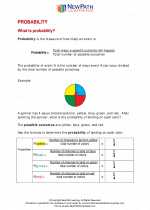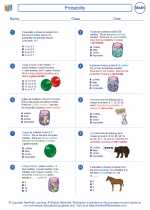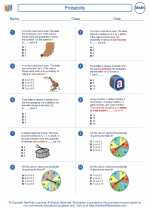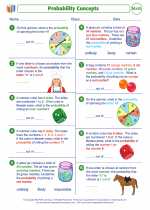Probability
Probability is the likelihood of a specific outcome or event occurring, expressed as a number between 0 and 1. A probability of 0 means the event will not occur, and a probability of 1 means the event is certain to occur.
Basic Concepts
- Sample Space: The set of all possible outcomes of an experiment. It is denoted by S.
- Event: A subset of the sample space, representing a specific outcome or a set of outcomes.
- Probability of an Event: The likelihood of an event occurring, denoted by P(E), where E is the event.
Calculating Probability
The probability of an event E is calculated using the formula:
P(E) = Number of favorable outcomes / Total number of possible outcomes
Types of Probability
- Classical Probability: Based on equally likely outcomes. P(E) = Number of favorable outcomes / Total number of possible outcomes.
- Experimental Probability: Based on observed data from experiments or real-life situations. P(E) = Number of times event occurs / Total number of trials.
- Subjective Probability: Based on personal judgment or experience.
Probability Rules
- Addition Rule: P(A or B) = P(A) + P(B) - P(A and B), where A and B are events.
- Multiplication Rule: P(A and B) = P(A) * P(B|A), where A and B are events, and P(B|A) is the probability of B given that A has occurred.
- Complement Rule: P(not A) = 1 - P(A), where A is an event.
Practice Problems
1. A fair six-sided die is rolled. What is the probability of rolling a 3?
P(rolling a 3) = 1/6
2. A bag contains 5 red marbles, 3 blue marbles, and 2 green marbles. What is the probability of drawing a blue marble?
P(drawing a blue marble) = 3/10
3. In a game, a player wins with a probability of 0.3. What is the probability of the player losing?
P(losing) = 1 - 0.3 = 0.7
4. A card is drawn from a standard deck of 52 cards. What is the probability of drawing a heart or a spade?
P(heart or spade) = P(heart) + P(spade) - P(heart and spade) = 13/52 + 13/52 - 0 = 26/52 = 1/2
5. Two coins are flipped. What is the probability of getting exactly one head?
P(exactly one head) = P(H1, T2) + P(T1, H2) = 1/4 + 1/4 = 1/2
Conclusion
Probability is a fundamental concept in mathematics and has applications in various real-life scenarios, such as games, statistics, and decision-making. Understanding probability allows us to make informed predictions and analyze uncertain outcomes.
[Probability] Related Worksheets and Study Guides:
.◂Math Worksheets and Study Guides Fifth Grade. Probability

 Worksheet/Answer key
Worksheet/Answer key
 Worksheet/Answer key
Worksheet/Answer key
 Worksheet/Answer key
Worksheet/Answer key
 Worksheet/Answer key
Worksheet/Answer key
